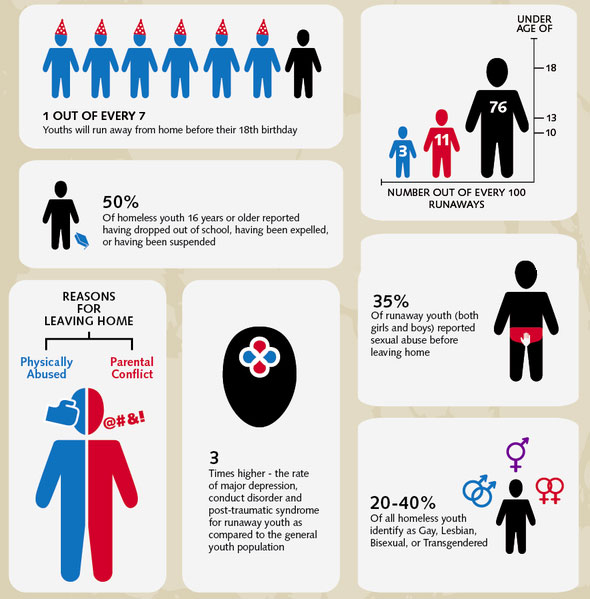This week we continue our effort to debunk the myths of homelessness. In Part 1 of our series, we tackled the myths that homelessness only happens downtown and that those experiencing homelessness are only the mentally ill, drug addicts or alcoholics. This week, we will look at the myth that youth are on the street because they’re rebellious and have run away from home and the myth that most people experiencing homelessness choose to be homeless.
Myth: Youth are on the streets because they’re rebellious and have run away from home
Reality: A study put forth by the Public Health Agency of Canada, entitled Street Youth in Canada, found the number one reason youth leave home is conflict with their parents. The same study also found that over half the surveyed population of street youth cited emotional abuse or neglect as a reason for leaving home. Some youth are forced to leave home. For example, the National Coalition for the Homeless states that as many as a quarter of homosexual teens in America are kicked out when parents or guardians discover their sexual orientation. This could account for the 40% of the American youth homeless population that identify as Lesbian, Gay, Bisexual, Transgender and Queer (LGBTQ).
We need stronger prevention and early intervention practices, because once a youth falls into homelessness, their health and wellbeing is at risk. A study conducted by the Shout Clinic of Toronto, which offers health care to youth experiencing homelessness, found that 31% of youth surveyed (men and women) reported working in the sex trade, increasing risks of contracting STIs—like HIV and Hepatitis—and becoming victims of abuse. Homelessness youth also show higher rates of suicide and drug overdose in comparison to housed youth.
In other words, the reasons a youth may face homelessness are important. The realities of the emotional and physical trauma, disease and violence that they face daily are too much to ignore. As a society, we need stop assuming that youth are on the street because there is something wrong with them. We need to accept our responsibility, provide resources and options to abused, neglected, and at-risk youth, to close the gateways to youth homelessness.

An excerpt from What You Don’t Know About Homeless Youth in America. Designed by Ryan K Fishman.
Myth: Most people experiencing homelessness choose to be homeless
Reality: Homelessness is driven not by choice but by a combination of economic hardship and lack of affordable housing.
Economic hardship can arise in a variety of ways, including family breakdown, illness, layoffs, disabilities, injury, addictions, or natural disasters. People don’t choose to be a victim of a workplace injury, to become seriously ill or to be laid off. Homelessness is, more often than not, a result of unexpected, sudden events as opposed to conscious choices.
When faced with economic hardship, a shortage of affordable housing, and a weak social support network, families and individuals can find themselves in a bind: once people at risk of or experiencing homelessness find supportive housing options, there are often lengthy waitlists. As a result, people remain, or step closer to homelessness.
The myth that people want to be homeless is just that – a myth. Victoria Cool Aid Society’s 2007 Homeless Needs Survey found that 97% of the 815 people surveyed want to have a home. People experiencing homelessness face a hard existence. The search for shelter and jobs is difficult and ongoing. Lack of quality sleep, exposure to illnesses, not knowing where your next meal is coming from, and other risks can lead to mental health and substance abuse problems. People are exposed to poor nutrition, inadequate health care, sexual assault, harassment, overcrowding, and physical assault, all leading to a shorter life expectancy.
Stay tuned for our next blog post addressing the myth that it would be too much of a burden on taxpayers to provide homes for those who experience homelessness.

I agree 100% with this statement. Never give up hope!
Proper parenting starts when kids are young. When there are challenges in life such as substance abuse, abuse, neglect and mental illness there will be serious to severe issues. No teen should live in fear or end up on the street. Consulting social services and meeting your teen half way counts. Teens on the street is never the right answer. Parent{s} must look into other realistic options.
A group home might be a temporary answer for some families. Never give up trying because this is STILL your child through the good, the bad or even the ugly. Parents are the first line of defense.
I think that Victoria, BC needs better housing for youth. Covenant House in Vancouver seems to be an excellent resource for all youth who need it…
Teens who run away need to meet with trusted people who can give them guidance and support. When they become adults, life will hopefully make better sense. Life on the street is never easy. Good luck to all street youth!